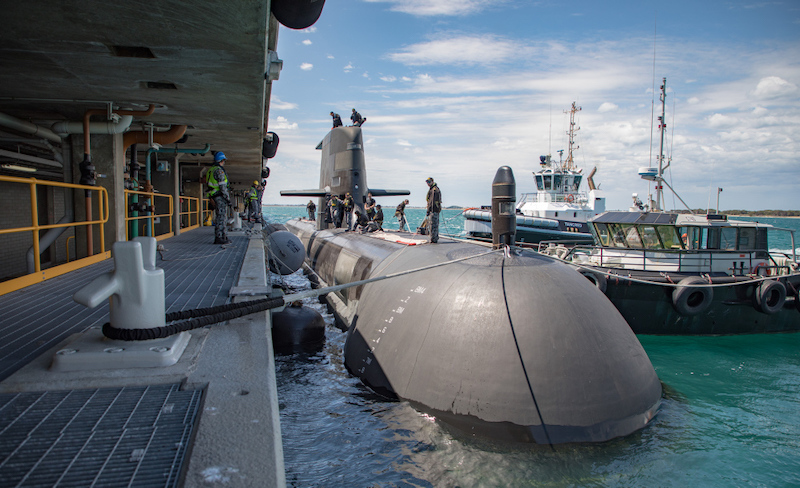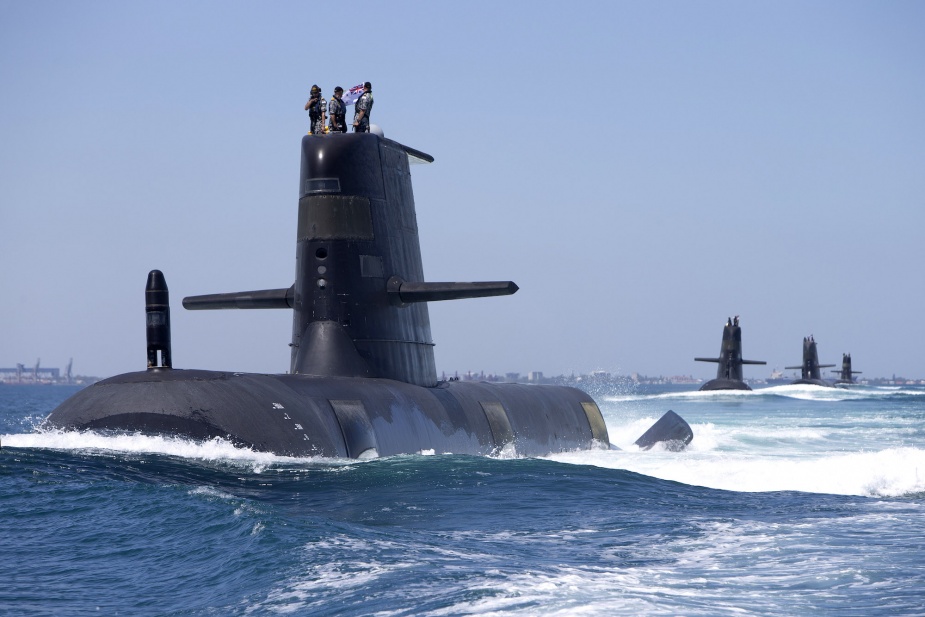A lack of operational submarines, stressed crews with no prospect of shore relief, a stalled training pipeline, and with morale and retention sinking, the Royal Australian Navy submarine force in 2007/8[1] faced a bleak situation.
The Australian Submarine Situation
The situation resulted after a tough two decades of struggle and the transition from the Oberon to Collins Class submarines, which led to a loss of submarine sea days and shortfalls in personnel numbers and experience. This difficult and challenging situation that the RAN faced a few years ago was due to a combination of five factors:
- A government decision against the Royal Australian Navy’s recommendation to change the dockyard undertaking the last two Oberon refits. This led to a blow out in cost, quality, and duration.
- When it became apparent that the Collins Class would be delayed in entering into service, there was no appetite to fund an additional refit to prolong the Oberon capability.
- The shift to a west coast submarine base compounded the manpower issues arising from the transition.
- Collins experienced significant first of class issues, delaying acceptance into service and reducing sea days for training and experience levels.
- The situation became the subject of critical cartoons and headlines, impacting morale, and public/political support.
A Decade of Initiatives
Given the compounded situation facing the RAN, it took over a decade to successfully recover from this state by implementing various initiatives. This included the establishment of a dedicated Submarine Capability Team to resolve the issues and deliver two ‘fast track’ submarines, which provided an interim operational submarine capability in 2001.[2] The team was also given additional funds and authority, unfettered by the usual Defence Committee structures. Through these efforts, the initial introduction into service issues were resolved but submarine availability continued to languish. In 2008, The Submarine Workforce Sustainability Review brought a non-submariner’s eye to the situation and provided a baseline for establishing a more sustainable manpower regime.[3] And finally, a review undertaken by Mr. John Coles, an independent expert from BMT Defence Services in the UK, flagged the need to rebuild the relationships between Industry, Navy, and Defence, to establish a national enterprise to deliver operational submarines against international benchmarks.[4]

After the sustained efforts by the national submarine enterprise members, the Final Report from John Coles [5]in 2016 noted a dramatic improvement – better than the benchmark for submarine availability, significant cost reductions per operational day (albeit at increased overall cost), five crews and at least two operational submarines available for deployment in pursuit of government objectives.
The Canadian Submarine Situation
From recent comments by the Commander of the Royal Canadian Navy, Vice Admiral Art McDonald[6], it seems that Canada today has no operational submarines, despite funding a force of four submarines that are split between the East and West coasts and manned by hard-working stressed crews. Both HMCS Chicoutimiand Windsor last underwent operational work programs in 2017, prior to operational deployments in 2018. HMCS Corner Brook has been sidelined since 2011, following a grounding incident, and work on HMCS Victoria and Windsor has been delayed due to COVID-19.
One can see similarities between the RAN’s earlier plight and that which the RCN is facing today. This article does not seek to tell Canada how to rectify what appears to be a stop-start submarine situation but to show that these similarities are worthy of consideration.
Why Submarines?
Submarines are technically very demanding and expensive to build, sustain, and safely operate (more like an underwater aircraft than a black frigate). It is worth reflecting on why navies bother with them.[7]
The answer lies in their stealth, which allows them to operate in sensitive areas without escalating a tense situation, observing, reporting, and where authorised, striking with great effect. Their possible presence injects great uncertainty into the calculation of an opponent, countering them is expensive and never guaranteed. As a result, they exert a significant deterrent effect. They also have a strategic impact, well above their small size.
In launching Australia’s Strategic Update and Force Structure 2020 in July[8], Australian Defence Minister, Linda Reynolds CSC said:
“Submarines are fundamentally important to our defence strategy. They are a unique – and powerful deterrent to any adversary, and they are critical to protecting our national security interests. Submarines secure Australia’s strategic advantage – through leading-edge surveillance and the protection of our maritime approaches. ” … “Our submarine capability – underpins Australia’s credibility and influence as a modern military power.”
Canada needs to decide if it wishes to possess a viable operational submarine capability and if so, how to achieve it. The Standing Senate Committee on National Defence recommendation for the acquisition of 12 submarines split between the Atlantic and Pacific coasts would be a good starting point.[9]
Similarities in Requirements
There are many similarities between Australia and Canada’s requirements of their submarine force. Both must operate over long distances, often across remote stretches of ocean, and master the complexity and expense of two ocean basing. Canada’s requirement to operate in a third ocean, the icy Arctic is unique. Conversely, Australia operates northward into very hot, tropical waters. These requirements point to a larger submarine than those used by many of the Western European Navies. The Attack Class project to design and build 12 large conventional submarines for Australia provides some indication of the time scales to be expected.
The Project was initiated in late 2008, the Defence White Paper 2009 called for 12 regionally superior, conventional submarines to be built in Australia, as argued in a submission from the Submarine Institute of Australia.[10] An exhaustive and protracted review of options followed to confirm that no suitable off the shelf submarine existed and a bespoke design would be required. In 2016, the French company, DCNS (now Naval Group) was selected to begin the ab initio design process, which is due to deliver the first operational submarine in the early 2030s; experience with ab initio submarine projects says it could well be later.
Lessons Learned
The lessons learned from Australia’s experience with the Collins Class project are well documented[11] and could provide some useful input to Canada’s considerations. To summarise some of the lessons drawn from RAN submarine experience, including rectifying the Collins Class transition.
A force of four (next generation) submarines should reliably provide one deployable submarine (and occasionally a second for a short period) in a single ocean basing scenario. Four submarines are spread too thinly for a two-ocean basing situation.
Note, the Netherlands operates four submarines, utilising a multi crewing regime (typically three crews across two operational SM), with a good level of shore support and a focus on crew respite, predictable deployment cycles, and close attention to conditions of service, to achieve one deployable submarine and a second available occasionally. Unlike the Canadian requirement, this is a single ocean basing situation and with shorter-range deployments.
Canada’s current defence policy, Strong, Secure, Engaged [12] commits to operate and maintain the four Victoria Class submarines, but makes no mention of what might follow. If, as seems reasonable, Canada requires a two-ocean submarine capability, able to provide at least one submarine deployable at long ranges on each coast, then at least four submarines and three, preferably four crews, with appropriate infrastructure, shore support, and basing would be required on each coast.
Finally, given the timescales involved in a delivering new submarine capability, there is no time to lose, as Admiral McDonald points out in a recent interview: “that conversation and effort regarding Victoria-class replacement have to happen soon”.
In the interim, an effort to build up crews and experience, possibly utilising a similar model to the Netherlands for basing, crewing, and upkeep would be a good starting point to achieve a steady-state operational capability and baseline for a future transition, that is, should a decision be taken to renew the capability?
The upcoming Deep Blue conference on October 29 and 30 is intended to help get discussions going amongst Defence and Industry about the acquisition of a sustainable, operational Canadian submarine capability.[13] I look forward to exploring these points further with you during my keynote speech and Q&A period that follows.
[1] https://www.aspistrategist.org.au/graphs-week-finally-getting-collins-class-paid/
[2] https://www.defense-aerospace.com/articles-view/release/3/3881/australia-deploys-upgraded-submarines-%28dec.-14%29.html
[3] https://www.defence.gov.au/publications/SubmarineWorkforceSustainability.pdf
[4] https://www.defence.gov.au/casg/Multimedia/Coles_Report_Final_22Nov12-9-7738.pdf
[5] https://www.defence.gov.au/casg/Multimedia/Coles%20Beyond%20Benchmark%20Report.pdf
[6] The Canadian Defence Review , Volume 26, Issue 4, p10.
[7] https://www.aspistrategist.org.au/why-submarines-for-australia/
[8] https://www.minister.defence.gov.au/minister/lreynolds/speeches/speech-australian-strategic-policy-institute
[9] https://sencanada.ca/content/sen/committee/421/SECD/reports/SECDDPRReport_FINAL_e.pdf
[10] https://www.submarineinstitute.com/userfiles/File/SIA_DWP2008_Submission.pdf
[11] The Collins Submarine Project – Steel, Spies and Spin, Peter Yule and Derek Woolner, Melbourne University Press, 2012
[12] http://dgpaapp.forces.gc.ca/en/canada-defence-policy/docs/canada-defence-policy-report.pdf
[13] Link to conference website.

